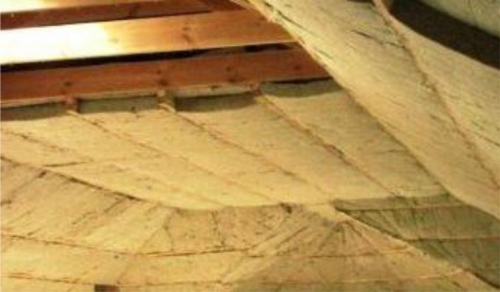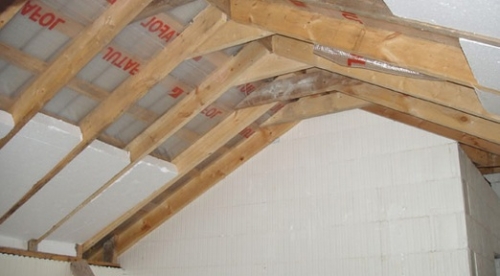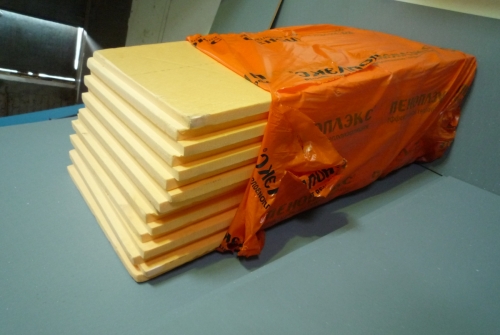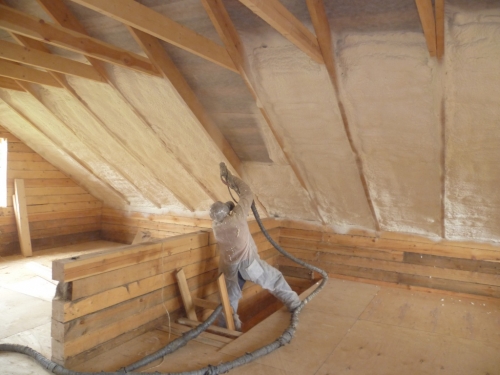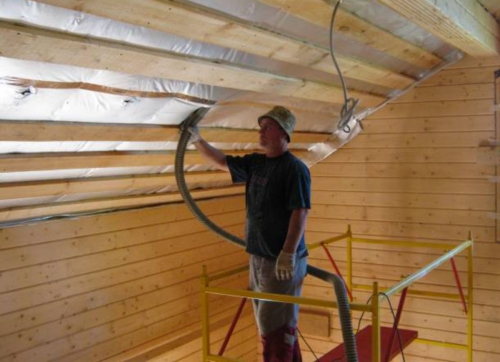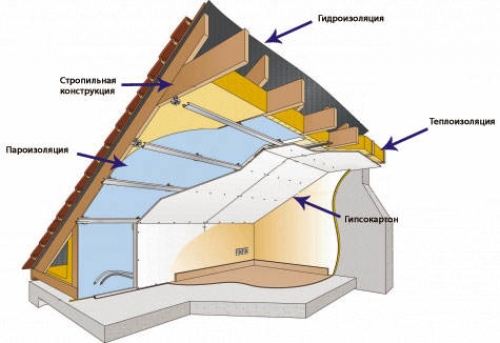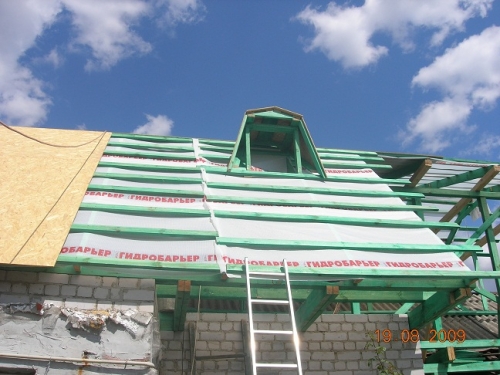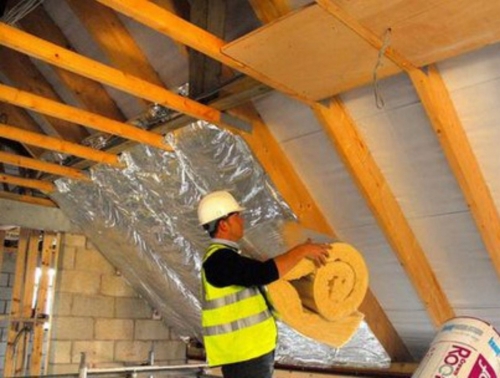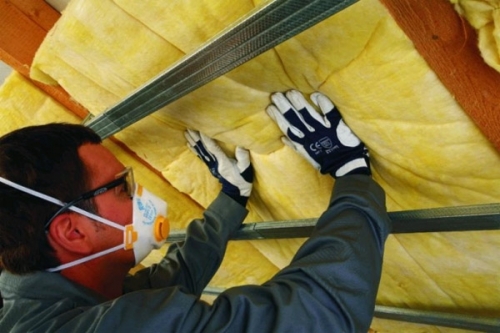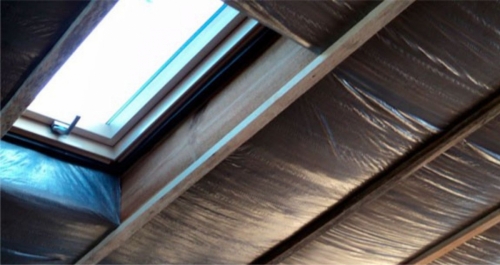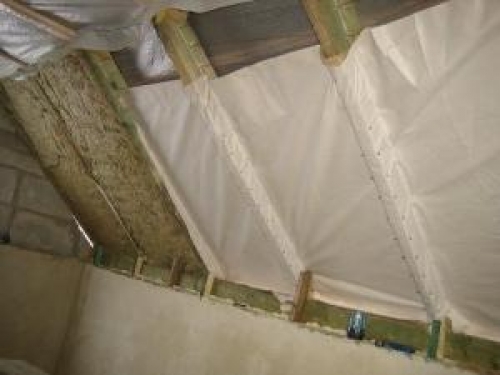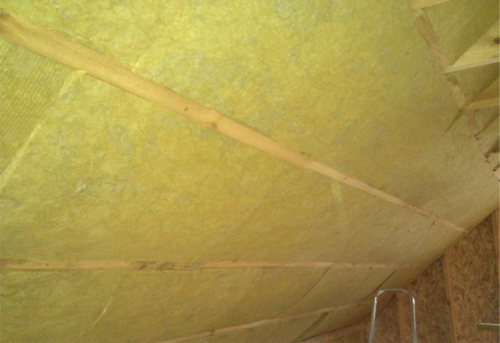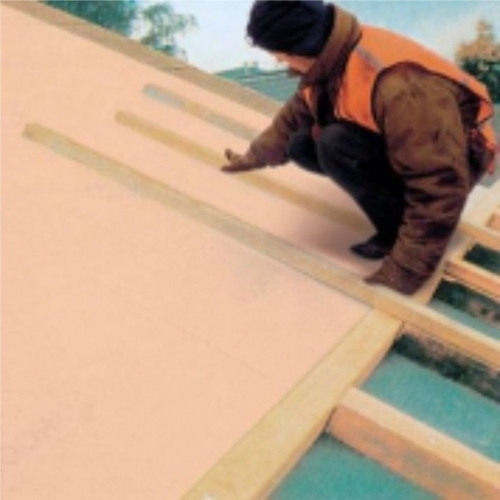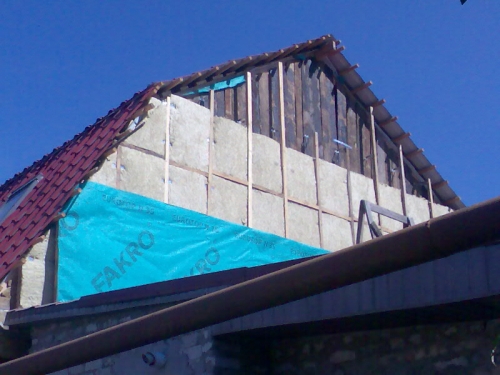The installation of water treatment systems solves many problems associated with increased ...
|
|
An important element of the design of a living or office space is a noble coating ... |
Remember how you chose the flooring for hours, searched for the suitable for color ... |
DIY APPLICATION

Every year, more and more of our compatriots fall under the temptation to equip a residential attic in his house. This makes it possible to expand the living space and adds some romance to the general concept of the house, especially if you install the attic windows. Almost all new suburban houses are originally built with the attic, but in old houses, the cold attics of compassionate hosts remake, warm, heating and equip. In order to make it warm and dry in the attic in the winter, it is cool in summer and the materials served for a long time, it is necessary to understand the very essence of the technology of insulation of the attic floor and understand the processes occurring in it. It is not difficult to carry out the insulation of the attic roof with your own hands, all the work is quite simple, only a partner and a tool will be needed. The main thing is to do everything correctly, then the thermal insulation material will last a long time, the woodwood will not get wet and will not rot, and as a result you do not need a fast major overhaul.
- Why is it necessary to warm the attic roof
- Materials for insulation of the attic roof
- How to properly warm the attic roof from the inside
- How to insulate the attic roof outside
- Video how to insulate the attic roof
Why is it necessary to warm the attic roof
The attic is a special room, its walls are almost closely pulled to the surface of the roof and ventilation gaps are no more than 10 15 cm. That is why the attic is quickly cooled in winter and inflated in the summer. The entire roof area is, as it were, the drive of solar heat in the summer, but most of the heat in winter goes through it. This is due to thermal conductivity of the materials from which it is made, and ventilation. For example, in winter, the heat that goes from heating radiators rises up, spreads under the roof set and safely disappears, since the roof material has high thermal conductivity. At the same time, the snow tears, turns into ice and destroys the material of the roof. And in summer, the surface of the roof is heated and transfers the heat of the entire structure, as a result, even the air becomes hot and stale. Two air conditioners will not cope with such a problem.
In the house with a classic cold attic, the situation is completely different. In it, the heat insulator function performs snow on the roof in winter and air in the attic. Folding thermal insulation materials on the attic floor plus air, enclosed in the attic, perfectly restrain the heat that goes from the side of the residential heated room. As a result, even in the most severe winters, the temperature in the attic does not drop below 0C - -2C. Thanks to this, snow does not stick on the roof and serves as an additional heat insulator. In summer, the air temperature in the attic can be adjusted by opening and closing the windows in the pediments, in fact, this is a real ventilation that removes excess heat from the attic, preventing overheating of the structural elements of the roof.
What to do with the attic? It is necessary to carefully heat up the room, correctly selecting the material, its thickness, place of styling and observe the technology. For example, if you use the insufficient insufficient thickness by eye, then it may not be enough, the snow will be tangled, and soon you will have to cross the roofing material, since the old one will come completely unusable. A sufficient width of the insulation will allow you to completely isolate the attic room from the roof, and the well -performed ventilation will take excess moisture and condensate from the underbuilding space. But first things first.
Materials for insulation of the attic roof
The choice of the best thermal insulation material for insulation of the attic roof is a very responsible task. It depends on the type of insulation how thick the insulation pie and the number of layers in it will be. In connection with the specifics of the place where the material will be applied, certain requirements are presented to it:
- Low heatwater. It is advisable to take material with a coefficient below 0.05 W/m*K.
- Low moisture permeability. Due to the fact that the roof can proceed, the material of the insulation should be moisture resistant and, if possible, not get wet or not lose its properties when getting wet. If this condition cannot be observed, then the insulation must be waterproof by excluding wetting.
- Small weight of the insulation is extremely important so as not to overload the structure of the roof. You can determine the weight of the material by its density. To warm the attic, mineral wool insulation with a density of 45 50 kg/m3, from fiberglass with a density of 14 kg/m3, can be used. Heavier slab options (200 kg/m2) are not suitable.
- Fire safety. It is desirable that the material does not burn or support combustion.
- The ability to keep in shape. Since the place of laying the insulation is unusual between the rafters at an angle, over time, light roll material based on mineral fibers can slide down, leaving large gaps at the top of empty spaces. Therefore, it is important to choose a material that will maintain shape and size for a long time.
- Resistance to severe frosts, temperature differences and the ability to withstand numerous changes in defrosting/frost cycles.
- Durability.
The thickness of the insulation for the attic is calculated for each case individually. This can be done using a special online calculator. For the calculation, it is necessary to indicate the construction region, the thickness of the walls of the house and their material, the thickness and material of the wall insulation, the thickness and material of the ceiling of the house, as well as the thickness and material of insulation of the ceilings. All this is extremely important for calculations of heat loss, based on which the thickness of the insulation is selected. If you select by eye, then in most cases, mineral wool with a layer of 250 mm is enough.
Consider the most popular materials that are used for insulation of attic roofs.
Mineral wool or glass wool One of the most successful solutions for insulation of the attic from the inside, although not perfect. Mineral wool fits perfectly into the space between the rafters, leaving no gaps, does not burn and does not support burning, weighs little and serves as an excellent heat insulator. The slab positions of basalt wool are perfectly kept in shape. But at the same time, it absorbs moisture quite strongly, like any cotton wool, so waterproofing from the roof and vapor barrier from the living room is required, since the mineral vapor also absorbs well. The wet minvata loses up to 60 % of its properties irrevocably, and its complete replacement is required. In addition, over time, she creams and crumbles, does not withstand mechanical loads.
Nevertheless, mineral wool remains one of the best materials for insulation of the attic roof with your own hands. It is inexpensive, it is easy to work with it, and compliance with the right technology will allow you to level its shortcomings. For different regions, the thickness of the insulation is calculated individually, but the minimum layer of mineral wool for the middle strip of the Russian Federation is 150 mm, in the colder regions the thickness must be increased to 250,300 mm.
Foam polystyrene or styrofoam An extremely popular material on the market, which everyone is trying to insulate, and what is possible and what is not worth it. Against the background of seeming ideal characteristics, low thermal conductivity, negligible weight, moisture resistance and rigid shape, foam has significant disadvantages. Firstly, various brands of polystyrene foam have varying degrees of fire safety from G1 to G4. And as practice has shown, for some reason the combustible foam G4 G4 is used for insulation, which can end very badly. After all, the fire spreads up if the attic is caught up, it will be unrealistic to survive in it. Secondly, it is not very convenient to work with polystyrene, since it crumbles when cutting and editing, gaps remain between the rafters that have to be closed in any cunning ways. Thirdly, the foam over time begins to crumble and collapse. Given all the disadvantages, the insulation of the attic roof with foam should not be done. This material can only be used in those meters where it will be hidden behind the floor screed or a layer of plaster.
Extruded polystyrene foamGreat material for insulation of the attic outside, i.e. If you lay it on the rafters under the roofing material. He is quite durable, not afraid of moisture, does not burn, perfectly holds shape. And that it is important that its very small layer from 50 to 100 mm is required.
Poliuretan foam Modern material, which is blown out using a special installation, leaving no slightest cracks or gaps. This is an indisputable plus, especially since such a spraying is easy to avoid cold bridges in the form of rafter legs. Poliuretan foam is not afraid of moisture, does not burn, weighs little and holds the shape perfectly. But he has a different drawback of low vapor permeability, he practically does not breathe at all. This means that in the room of the attic will always be unpleasant wet, if not equipped with forced ventilation.
Ecowata One of the most ideal options in the question of how to better insulate the attic roof. She is also blowing into all the cracks, is not afraid of moisture, practically does not burn, weighs little, breathes and, most importantly, absolutely environmentally friendly, unlike all other materials. Its evaporation or random particles are not able to harm, unlike it is mineral wool.
When choosing a heater for the attic roof, pay attention not only to the characteristics of the material itself, but also the purely constructive features of its use. For example, laying mineral wool between the rafters allows, if necessary, to disassemble the insulation pie and check the condition of the rafters, repair them, and then the mineral wool slabs can be easily put in place. If you spray polyurethane foam into the space between the rafters, then the rafters become almost inaccessible to the revision. So you need to treat everything wisely.
How to properly warm the attic roof from the inside
The most common way to warm the attic from the inside if the space allows or not other contraindications. To do this, use insulation based on mineral wool, glass wool and less often extruded polystyrene foam. Polyurethane foam or ecovata is even less likely to blow.
The scheme of insulation of the attic roof from the inside
Compliance with the correct insulation of the attic roof is the key to the durability of materials and the comfort of living in the attic.
The capture pie of the attic roof (from the inside out):
- Finishing material.
- Ventilation gap with a crate.
- Vapor barrier membrane.
- Mineral wool or glass wool insulation.
- A waterproofing membrane that produces steam and does not pass moisture inside.
- Ventilation gap with a crate.
- Roofing material.
Vapor barrier filmit is necessary to use it if there are cotton materials as insulation. So mineral wool can be protected from wet vapors of a dwelling. If, instead of mineral wool, polyurethane or ecowata foam is used, then vapor barrier is not needed.
Waterproofingin any case, regardless of the insulation used, it will protect wooden elements of the roof structure. As waterproofing, it is necessary to use superdiffusion membranes that can produce steam outward and not pass moisture inward. Between the waterproofing film and roofing material, a ventilation gap from 4 to 10 cm thick is required, depending on the type of roof. Excess steam from the insulation will go through it.
The laying of the insulation between the robes of the attic roof
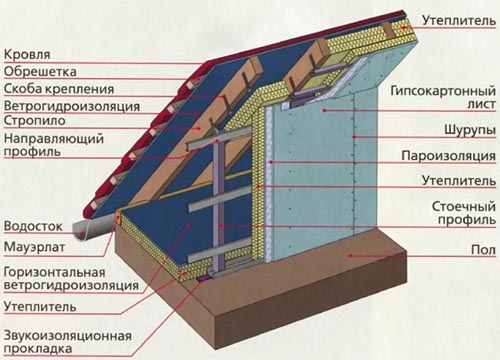
The insulation of the attic roof from the inside is best done at the stage of building a house. Then all the stages of work will be completed correctly. Before the start of insulation, it is necessary to determine, and where we will insulate. To do this, draw a drawing of the attic with exact dimensions and mark where the interior space will be. For example, if the living space will occupy the entire area, including the roof slope to the very ceiling, then the entire roof slope must be insulated. If the room is, as it were, circumcised, i.e. Between the ramp and the interior will be free space, then it will be necessary to insulate strictly according to the drawn scheme, leaving the free space for ventilation. But then in narrow areas near the very edge of the roof it will be necessary to insulate the ceiling.
Consider the option of insulation of the entire roof slope:
- Even at the construction stage, before laying the roofing material, it is necessary to waterproof the roof. To do this, we lay the waterproofing membrane on top of the rafters, start from the bottom up, making a overlap at least 15 cm and gluing joints with self -adhesive ribbons. The film must not be spread out so that it does not break when frosts come. It must be laid with a sagger not more than 2 cm per 1 m. Nit with a construction stapler to the rafters to the rafters. If this is not, then you can use galvanized nails with a wide hat.
- Near the crate from wooden bars on top. Their thickness is selected depending on the required size of the ventilation gap, at least 2.5 cm. We fix the crate with corrosive screws. In order not to injure the film once again, we make holes in the bars in advance.
Important! For greater reliability, two ventilation gaps can be made: between the insulation and waterproofing, between the waterproofing and the roof. This will protect the material from getting wet, if the condensate suddenly accumulates on the film.
- On the crate we lay the roofing material tiles, corrugated board, slate, metal. Here, for the installation of a soft roof, it is first necessary to nail the sheets of chipboard or moisture -resistant plywood on top of the crate, which will serve as the basis for fastening.
- Work move inside the attic. We unpack the insulation of mineral wool and let it lay down and straighten. Cut into the necessary pieces. The width should be 20 30 mm larger than the distance between the rafters so that the canvases are kept by display.
- Pour the fabric of the insulation into the space between the rafters. We press in the middle of the canvas, and the edges straighten themselves. The thickness of the rafters should be 200 250 mm.
Important! The step between the rafters is convenient to select for the size of the future insulation. Rolls are sold 1200 mm wide. A step can be made 1200 mm or 600 mm, then the roll will need to be cut in half.
- On top of the insulation we lay a vapor barrier material with an overlap 10 cm, glue the joints with tape. We fix it with brackets or using a crate.
- We stuff the crate from the racks with a thickness of 25 mm.
- We fix the finishing material on the slats.
The insulation is completed on this. For a more clear example, you can watch video insulation of the attic roof.
If you plan to insulate the attic in an old or already built house and do not want to shoot roofing material, then you can cheat a little. The waterproofing film can be spread inside the attic, wrapping the rafters with it and starting into the space between them. But in this case, wooden rafters are unprotected in case of leaks.
Laying insulation under the rafters of the attic roof
The method of insulation is a little less common when the material is laid inside the attic on top of the rafters, and not into the space between them. The main reason can be avoided by the bridges of the cold, which are wooden rafters. And so dense fit of thermal insulation material will ensure the absence of cracks, and the free space between the rafters will serve as additional ventilation. A very successful solution if the attic space allows you to reduce it by at least 30 cm on each side.
The insulation of the attic from the inside of the room:
- From the inside, we navigate the waterproofing membrane on the rafters.
- We attach suspensions for the ceiling made of drywall to the rafters so that with their P-shaped hole they look at each other.
- We start the insulation in the suspensions. We cut the canvases with a small fiber to exclude the appearance of cracks. The result should be a continuous shell of the insulation. We plan in the course of the rafters.
- Close the insulation with a vapor barrier film, fasten it with brackets.
- We stuff the crate for finishing material. For consolidation, we use long nails 150 200 mm to break through the insulation and get to the rafters.
In principle, this method can be combined with laying the insulation between the rafters. The first layer will be between the rafters, and the second will block everything, including the bridge of the cold.
How to insulate the attic roof outside
You can insulate the roof outside only at the construction stage or if you remove the roofing material. This method of insulation allows you to leave the attic space in its original form without loss of area. Also, many design solutions involve the use of rafters as decorative elements of the situation.
The technology of the attic roof on the outside
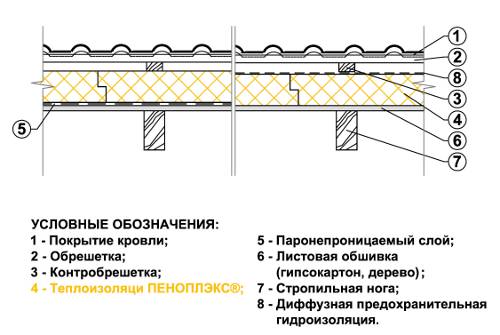
The attic is insulated outside is carried out only by dense slab materials. These include extruded polystyrene foam or foam. He is not afraid of moisture, so it does not require vapor barrier. Penoplax insulation pie will look like this:
- Plates of extruded polystyrene foam.
- Waterproofing membrane.
- Ventilation gap with a crate.
- Roofing material.
An indisputable plus of this method of insulation is that the rafters are available for inspection and repair at any time.
Laying insulation on the rafters of the attic roof
Warming with extruded polystyrene foam over the rafters allows you to create a continuous thermal insulation layer without cold bridges.
- So that the material does not slip from the roof, at the very bottom to the rafters, we nip the board, a width equal to the thickness of the insulation (from 50 to 100 mm).
- We spread the heater slabs in a checkerboard pattern. It is necessary to start from below, from a fixing rail.
- We fix them to the rafters using special dowels with a grib hat.
- We spread the waterproofing film, starting from the bottom up, with an overlap of 10 15 cm, glue the joints with tape. The film is necessary to protect the material from leaks and condensate.
- We fill the crate from bars with a thickness of at least 40 mm.
- We mount the roofing material.
Extruded polystyrene foam is not required from the inside.
It is necessary to insulate the pediments of the attic room together with the entire facade of the building, i.e. outside. The choice of insulation material is completely dependent on the material from which the house is built, and the preferences of the owner. For example, if insulation is carried out using a hinged facade system, then mineral wool with vapor barrier and waterproofing films can be used. And if a wet facade is planned, then a foam can be laid under it. Do not forget that compliance with the technology is the key to success.

